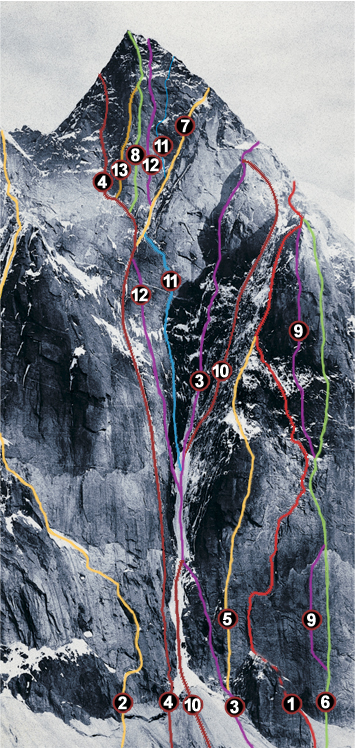
The north face of Rocky Ak-Su Peak, showing, in chronological order, (1) Troschinenko/Original North Face Route (6A, 1982). (2) Kavuneko/Left Pillar (6A, 1984). (3) Moshnikov’s Split 96B, 1984). (4) Popov/Central North Face (6B, 1986). (5) Kostenko/Right Buttress (6A, 1988). (6) Pershin/Right Buttress Direct (6B, 1988). (7) Chaplinski/Central North Face (6B, 1988). (8) Shabalin First Variation/Central North Face (a.k.a. The Nose, 6B, 1994). (9) Klenov Variation/Right Buttress Direct, (6B, 1996). (10) Antonov/Cold Corner Route (6A, 1997). (11) Ruchkin/Direct North Face (6B, 1997). (12) Klenov/Direct North Face (6b, 1998). (13) Shabalin Second Variation/Nose Direct (6B, 2002).
[Photo] Pavel Shabalin
Early in February, a six-man Russian team accomplished the first winter ascent of the Ruchkin-Odintsov route (6B, 1996) on the 1700-meter north face of Rocky Ak-Su (5217m). Rocky Ak-Su lies in the Pamir-Alai on the border of Kyrgyzstan and Tajikistan; although the north face proper has never been attempted by westerners (in 1990 Mick Fowler and partner climbed the “easy” route–the West Ridge–on the peak; Fowler remembers it as being “rather severe”), it has a reputation for being a vertical testpiece for serious alpinists. In 1998 Misha Pershin and Igor Nefedov endured a “winter cocktail” on the Chaplynsky route (6B, 1988) that slammed them with snow, wind and -35 degree C weather for a month. They persevered to make the mountain’s first winter ascent; the only other winter ascent was also made in 1998, by the Shabalin- Tukhvatullin-Mariev team on the Cold Corner Route (6A, 1997).
This January eight Russians arrived in base camp hoping to make the third winter ascent of the face. They split into two teams: a pair, Evgeny Dmitrienko and Vladimir Arkhipov, and a group of six, led by Oleg Khvostenko. Dmitrienko and Arkhipov had originally planned to climb Moshnikov’s Couloir (6A, 1984), but upon arriving in camp opted for Chaplinsky’s Central North Face (6B, 1988), which takes a more direct finish to the face, instead.
Dmitrienko and Arkhipov made quick work of the initial 8-pitch ice couloir on January 27, and continued up ten more pitches with good weather over the next two days. All seemed well until Dmitrienko took a lead fall on January 29, injuring his leg. Although not life-threatening, the pair decided the injury was “incompatible with 6B” and descended to camp without aid, shutting down their hopes for an Ak-Su ascent this winter.
Meanwhile, the young team of six led by Oleg Khvostenko tackled the Ruchkin-Odintsov route (6B, 1996). On January 31, after five days of climbing, they intersected their counterpart’s route and set up portaledges in the top section of a dihedral 500 meters below the summit ridge. An earthquake and an incoming storm put the six in darker spirits: the rock above was the route’s most demanding. Persevering through varying degrees of snow for five more days, the Russians summited on February 5, spent the night, and descended via the same route the following day.
The Russians’ accomplishment marks the first winter ascent of the Ruchkin-Odintsov route, a climb that has seen no ascents, winter or summer, in the past decade. When Ruchkin and Odintsov opened the route, it became one of the first climbs of the Russian Big-Wall Project; the project has since established new routes on Norway’s Troll Wall, India’s Bhagirathi III and the north face of Jannu, among many others. An article by Odintsov, orginator of the project, will appear in Issue 19.
Reports from Mountain.ru